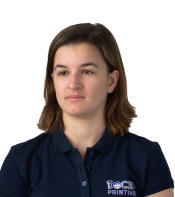ESR05 - Chloé Goutagny
|
|
Nationality: |
French |
|
Host Institution: |
CRIBC, Belgium | |
|
Supervisor: |
Stéphane Hocquet, CRIBC | |
|
Subject: |
Manufacturing of bioceramics complex structures by using stereolithography, freeze-casting and rapid sintering processes |
Background:
Chloé did two years of preparatory classes where she studied physics, chemistry, mathematics, French and English in order to prepare competitive exams for engineering schools. She was admitted at the INP-ENSIACET (National Polytechnic Institute of Chemical Engineering and Technology) in Toulouse where she studied material science for three years. During those three years she also did three internships in several companies:
- In 2016, she worked for a month as a laboratory technician in a company specialised in plastic production, named Barbier Group, in France.
- In 2017, she worked during four months as a research student at the University of Manchester, on a project involving the manufacture of self-healing polymers.
- Finally, in 2018, she worked for six months in England, in an Health Care company called Smith and Nephew. She was based on their Advance wound care site in Hull, and was part of the Research and Development team working as an assistant development scientist in New product development.
At the end of her last internship she was graduated and got a Material Science engineering diploma from the ENSIACET in October 2018. She is currently working as a PhD student in the Belgium Ceramic Research Centre.
Presentation of the individual project:
Her subject is focused on the optimisation of the stereolithography technique using bio-ceramic powder as raw material, such as hydroxyapatite and β-Tricalcium Phosphate. The stereolithography requires the use of a photopolymer resin as a binder, therefore a slurry is made by mixing the powder with the resin. Layer by layer the slurry is illuminated by UV light which leads to the polymerisation of the resin and the building of the part. After that the green part is obtained which is composed of the ceramic powder trapped inside the polymer. Then it undergoes a debinding step and a sintering step in order to obtain the final dense ceramic part.
All the steps of the process are going to be investigated, starting with the slurry manufacture. The final objective being to print dense ceramic parts that are suitable to be used as bone implants. Therefore, some biological tests will also be part of the work during the PhD.


